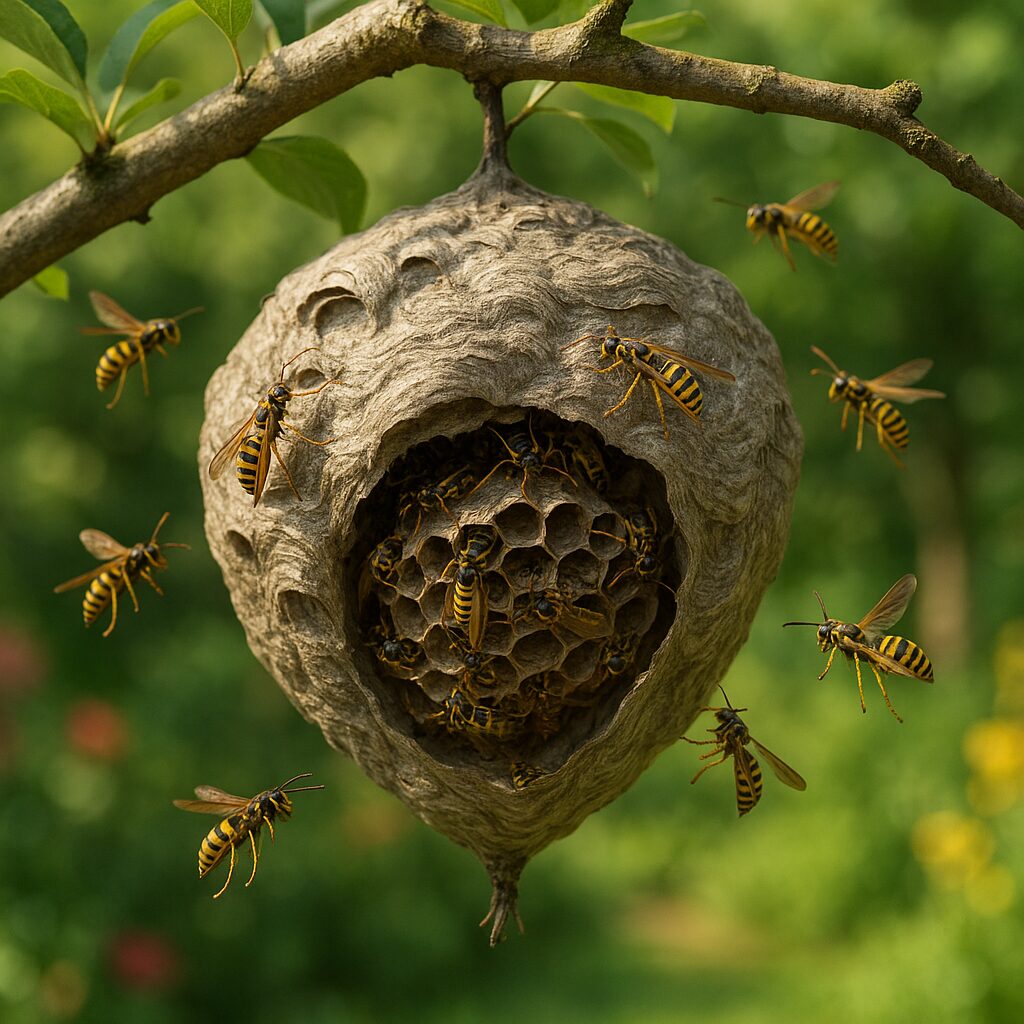Getting rid of wasps can be a nerve-wracking task, especially if you’re concerned about getting stung. Wasps are protective of their nests and can become aggressive if threatened, so it’s important to approach the problem with caution, preparation, and the right techniques. This comprehensive guide will walk you through how to safely remove wasps and their nests from your home or garden, minimize your risk of stings, and prevent them from returning.
Understanding Wasps and Their Behavior
Before taking action, it’s essential to confirm that you’re dealing with wasps and not bees, hornets, or other insects. Wasps are typically slender with a narrow waist, smooth bodies, and bright yellow and black markings. They build papery nests, often under eaves, in sheds, or in trees. Unlike bees, wasps can sting multiple times and are more likely to become aggressive when their nest is disturbed1.
Step 1: Identify the Nest and Assess the Situation
-
Locate the Nest: Observe where wasps are flying to and from. Common nest sites include under roof eaves, in wall cavities, trees, shrubs, or garden sheds12.
-
Assess Accessibility: If the nest is high up, inside a wall, or otherwise hard to reach, it may be best to call a professional pest control service124.
-
Size and Activity: Smaller nests early in the season are easier and safer to remove. Large, established nests with heavy wasp activity pose greater risks1.
Step 2: Gather Protective Gear
-
Wear Thick, Loose Clothing: Cover your entire body. Thick, loose clothes are harder for wasps to sting through. Wear long sleeves, pants, closed shoes, and tuck pants into socks1.
-
Protect Your Face and Hands: Use gloves (washing-up gloves work), a hat, goggles, and a face mask to shield your face and neck1.
-
No Gaps: Ensure there are no gaps in your clothing where wasps could crawl inside.
Step 3: Choose the Right Time
-
Dusk or Night: Wasps are less active and all are likely to be inside the nest at dusk or night, making this the safest time for removal1. Use a red-filtered flashlight to avoid attracting attention.
-
Avoid Windy or Rainy Conditions: Calm, dry evenings are best for nest removal.
Step 4: Select a Safe Removal Method
1. Wasp Sprays and Foams
-
Commercial Wasp Sprays: These are designed to be used from a distance (up to 2 meters/6 feet). The foam expands to cover the nest and kills wasps on contact128.
-
How to Use:
-
Safety: Always wear protective clothing and have a clear escape route.
2. Wasp Traps
-
DIY Traps: Use an empty soda bottle with sweet bait (jam, fruit juice, or soda). Cut a hole for wasps to enter; they’ll be attracted, enter, and become trapped24.
-
Glass Traps: Commercial glass traps with sugary bait can also be effective. Hang these away from high-traffic areas2.
-
Limitations: Traps reduce wasp numbers but do not eliminate nests.
3. Natural Repellents and Deterrents
-
Essential Oils: Wasps dislike the scents of lemongrass, geranium, clove, peppermint, and basil. Mix a few drops with water in a spray bottle and apply to areas where wasps gather34.
-
Waspinators: These are fake nests that exploit wasps’ territorial instincts. Hang them near doors, patios, or eaves to deter wasps from building new nests2.
-
Soap Solution: Mix water and dish soap in a spray bottle. The soap coats wasps’ wings, impairing flight and suffocating them. This method is best for single wasps indoors5.
4. Physical Removal (For Small or Early Nests)
-
Glass Jar Method: For very small nests, place a glass jar over the nest and slide a stiff piece of paper behind it to dislodge. Keep the jar sealed and relocate the nest far from your home7.
-
Shop Vac Method: Some use a shop vacuum to suck up wasps at the nest entrance (especially at night). This is risky and should only be attempted with full protective gear and caution6.
Step 5: Removing Wasps Indoors
-
Encourage Exit: Open windows and doors, turn off indoor lights, and open curtains to guide the wasp toward the light and outside5.
-
Trap and Release: Wait for the wasp to land, then gently cover it with a glass and slide a stiff paper underneath. Carry it outside and release5.
-
Avoid Swatting: Swatting can provoke wasps and release pheromones that attract more wasps5.
Step 6: When to Call a Professional
-
Inaccessible Nests: If the nest is inside walls, high up, or in a difficult location, professionals have the tools and experience to remove it safely124.
-
Large Nests: Big, established nests with many wasps are dangerous to tackle alone.
-
Allergies: If anyone in your household is allergic to wasp stings, do not attempt removal yourself.
Step 7: Preventing Future Wasp Problems
-
Seal Entry Points: Repair cracks and gaps in walls, roofs, and around windows to prevent wasps from nesting inside structures4.
-
Remove Food Sources: Keep garbage bins tightly sealed, clean up fallen fruit, and avoid leaving sugary drinks or food outside4.
-
Hang Waspinators: Place decoy nests early in the season to deter wasps from building nearby2.
-
Plant Repellent Herbs: Peppermint, lemongrass, and basil can help keep wasps away from patios and entryways4.
-
Regular Inspection: Check for early signs of nest building in spring and remove small nests promptly.
What to Do if You Get Stung
Despite precautions, stings can happen. Here’s how to treat them:
-
Wash the Area: Clean with soap and water to remove venom1.
-
Apply Ice: Reduces swelling and pain.
-
Pain Relief: Use over-the-counter painkillers if needed.
-
Monitor for Allergic Reaction: Seek immediate medical attention if you have trouble breathing, swelling of the face or throat, or other signs of anaphylaxis1.
Frequently Asked Questions
What time of day is best for wasp nest removal?
Dusk or nighttime is safest, as wasps are less active and most are inside the nest1.
Will wasps return to a destroyed nest?
Some may linger for a few days, but once the nest is gone, they will eventually move on1.
Are homemade wasp repellents effective?
Essential oils and herbs can help deter wasps but are not a guaranteed solution for established nests4.
Should I use ultrasonic or sound deterrents?
Evidence for their effectiveness is limited, so physical and chemical methods are more reliable4.
Summary Table: Safe Wasp Removal Methods
| Method | Best For | Key Safety Tips | Effectiveness |
|---|---|---|---|
| Wasp Spray/Foam | Accessible outdoor nests | Wear full protection, spray at night | High (for nests) |
| Wasp Traps | Reducing numbers | Place away from people | Moderate |
| Essential Oil Spray | Deterring wasps | Use in frequented areas | Low to moderate |
| Soap Solution | Single indoor wasps | Spray lightly, guide outside | High (indoors) |
| Glass Jar Relocation | Small, accessible nests | Move slowly, wear gloves | Moderate (small nests) |
| Professional Removal | Large/inaccessible nests | Let experts handle | Very high |
Conclusion
Safely getting rid of wasps without getting stung is all about preparation, timing, and knowing your limits. Always wear protective clothing, work at dusk or night, and use wasp sprays or foams from a safe distance for nest removal. For single wasps indoors, encourage them to leave or trap and release them gently. Don’t hesitate to call a professional for large or hard-to-reach nests. Finally, take preventative steps to keep wasps from returning. By following these strategies, you can reclaim your space from wasps while minimizing risk to yourself and your family12458.
- https://www.daltonsupplies.com/blogs/news/get-rid-of-wasp-nest-without-getting-stung
- https://www.eliminatesolutions.co.uk/safe-methods-for-getting-rid-of-pesky-wasps/
- https://www.treehugger.com/how-to-get-rid-of-wasps-naturally-4868787
- https://pestczar.com/how-to-safely-get-rid-of-wasp-nests-without-getting-stung/
- https://www.flick.com.au/blog/how-to-safely-remove-a-wasp-from-indoors/
- https://www.youtube.com/watch?v=HcknKdjuiKs
- https://www.reddit.com/r/insects/comments/vwxumb/help_i_need_to_relocate_these_wasps_without/
- https://www.marthastewart.com/8293951/how-to-get-rid-of-wasps







